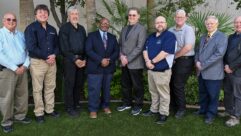
As another, but briefer, FM translator window for AM owners approaches — opening for Class C and D stations on July 26 — Radio World is reaching out to industry members for their assessment. Gregg Skall is a partner with Womble Carlyle Sandridge & Rice.
Radio World What kind of interest are you sensing?
Gregg Skall: I’m sensing an ever-increasing awareness and interest in the FM translators. A lot of AM stations that could not participate in the 250-mile waver windows have been waiting for this window. Still others have not jumped right away because they’re a bit concerned about winding up in an auction. As we get closer to the window filing date, I think there will be a rush of applications.
As people think about it more actively, they are coming to realize that there are number of reasons to be interested in this window. Aside from potentially enhancing the AM station’s value, the commission’s recent siting rule revisions have created some new interest, since they allow locating the translator 60 dBu anywhere within a 25-mile radius. This allows extending the translator potential coverage where many had not previously thought possible.
Also, this window allows AM stations that had “pre-250-mile-waiver window” translators to add a second translator, provided it covers new reception areas.
Another incentive I am increasingly hearing is created by the possibility that the FCC may authorize AM all-digital operation on a voluntary basis within a year or two. The NAB Lab demonstrations of a few years ago demonstrated the astounding sound quality of AM all-digital. FM translator service may be critically important to allow a transition to all-digital AM while continuing to serve the station analog audience with the FM translator.
Finally, the stations are realizing that with the three-year construction permit, they will not necessarily have to build right away and will have some time to make the decision of whether or not to construct.
RW: The window is short this time — just one week.
Skall: The short window is indeed quite notable. Not only does it compress into one short week all of the application preparation, but as of now, the Form 175 cannot even be prepared prior to the opening of the window. That will place a great deal of strain on the auction portal. In addition, coming at the end of July during vacation season, it may hit when many who wish to apply are in the middle of a preplanned vacation. A longer period of time, or the ability to prepare the Form 175 in advance, would be very helpful.
RW:How many applicants do you think we’ll see in this window compared to the prior ones?
Skall: The commission says it has processed more than 1,000 applications in the 250-mile waiver windows. Since all of those stations would be ineligible for this third window, and since many stations have previously obtained FM translators, I would expect that this window for new FM translators will see substantially less applications. But to the extent that there is spectrum available, I think we will see a lot of applications.
RW: Looking at the past year or two in translators, with the AM windows and the easing of site restrictions, how successful do you feel the overall AM revitalization effort has been?
Skall: The FM translator initiative has been enormously successful. But, it is not really “AM” revitalization. Some have called it the FM-ization of the AM band. As former FCC Chairman Mark Fowler noted in your May 2, 2017 edition, real AM revitalization requires a long-overdue revision of FCC rules to align AM technical standards with reality. He noted that true revitalization of the AM band requires focusing on changing the rules from a contour protection to an anti-interference pro-service agenda. A chief effort in that regard would be adoption of a method to take into account actual nighttime interference levels, which in reality are the desired/undesired signal ratios calculated for Class A stations.
The current standard wrongfully assumes a Class A receives no interference at all within its 0.5 mV/m 50 percent sky wave contour. Fixing the AM band is possible, but it will require more than FM translators. I also think that it is vital that the commission begin to allow AM all-digital service on a voluntary basis.
RW: What’s your take on interference issues between translators and full-service broadcasters, and the question of whether some are “gaming” the rules in ways that weren’t intended?
Skall: While there have been notable examples of situations where some translator licensees have been “gaming the rules,” as you say, there have been instances of abuse on both sides. In some cases, translator licensees have extended signals into areas of full-service station coverage, insensitive to the regular listeners of those stations who happen to be outside of the commission’s predicted interference service contours. In others, there have been egregious claims of service and interference clearly beyond any reasonable station reach.
The fact remains, however, that under current commission rules, full-power stations are a primary service and FM translators are a secondary service for good reason. They are duplicating the service of a full-power station already presumed to be serving their audience on a different band. That said, the commission should take a hard look and consider a more realistic standard for determining where reasonable service can be expected from a station. The commission’s acceptance of Longley-Rice as a more accurate prediction model under circumstances reinforces the fact that the commission needs a more precise method for determining actual coverage expectations than the predicted 50/50 contours currently used in the system.
RW: We understand that following a conversation you had with staff members at the commission, the staff moved to implement a new filing opportunity. Can you explain?
Skall: Given the extremely short filing window, a critical problem was presented by the requirement that applications could be filed only by the AM station licensee or permittee. There will certainly be transactions in process during that-one week window with assignment applications on file or being filed that week. These “prospective licensees” may not be able to close by Aug. 2 or the commission may not be able to grant the applications during that week due to the public notice requirement. Some of these deals may even have been made on the understanding that an FM translator application is to be filed during the upcoming window. Under the policy when the public notice was issued, these proposed licensees would not have been filed.
In my discussions with FCC staff, I do not think they anticipated these situations when the Public Notice was issued. Thankfully, they recognized the injustice and have said that where an assignment application accepted for filing and is on file during the window, the buyer may now file the application. My understanding is that in such a situation, the application will be good only for that proposed assignee and the transaction must close.
RW: What else should we know?
Skall: If you’re interested and you’re a Class C or D that did not take advantage of the 250-mile waiver windows, it’s time to get to work. Prepare your applications early and get them ready to file in the window. Be prepared with the information necessary for the Form 175. Once the applications have been filed, study them to determine whether are there are any mutually exclusive applications that would force you into an auction and look for opportunities for a negotiated settlement or determine what possible alternatives there are to mutual exclusivity being determined by the auction.












